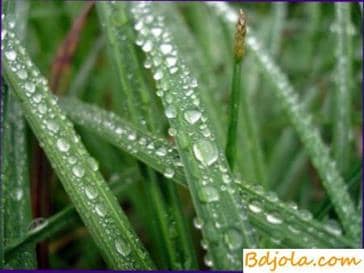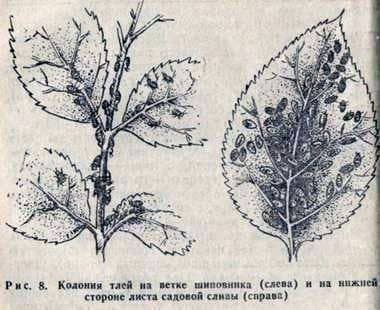
In addition to nectar, which is allocated by flowering and non-flowered nectaries, bees, under certain conditions, collect and carry in the hives a sweet liquid appearing on the leaves of certain plant species. Sometimes isolated her small insects (aphids, leaf-blocks and chervets), parasites on plants, and sometimes themselves
Plants without the participation of insects. In the first case, the liquid is called a drop, and in the second case – honey dew.
Fall. The main contributors to the padi are aphids, small insects, 3-6 mm in length, located in large numbers from the underside of the leaves.

There are over 600 species of aphids adapted to life and reproduction on many widespread trees and shrubs. A characteristic feature of the structure of the body of aphids is that the head, chest and abdomen are tightly connected to each other, they have a sturdy proboscis that thrusts deeply into the leaves and fresh shoots of plants, and they reach the sieve tree tubes through which the sweet liquid moves, and The juice of aphid plants is used for nutrition, but most of it is spent on the cultivation of young individuals.
Aphids are distinguished by their extraordinary ability to reproduce. The beginning of the reproduction of aphids usually coincides with the dissolution of leaves on trees. At this time, from the fertilized eggs laid in the fall, the first generation is excreted. After 8-10 days from each individual, the second generation consisting of 10-30 aphids, only females, is excreted. In the subsequent period, 8-10 generations are excreted for the warm period of the year, and The number of aphids from one individual from spring reaches many millions. Among the summer appear winged females and males that fly to other parts of the plant and to new plants. Winged females lay eggs that overwinter.
The aphids have numerous enemies: they are eaten by birds, mites, ants, spiders and other insects. A lot of aphids die under adverse weather conditions, from cold, heavy rains, strong winds, etc. Therefore, in some years there are few aphids by autumn, but sometimes their number reaches dangerous values for plants, and they allocate a lot of padi.
Juice, sucked by aphids, contains from 6 to 28% of dry matter, mainly sugar. In this juice there are few protein substances necessary for the growth and reproduction of aphids. To satisfy their need for protein, the aphids have to pass through their intestines a huge mass of juice. In addition, on hot days aphids vaporize a lot of water through the surface of the body. Therefore, in the warm days of autumn, they almost continuously suck the juice from the plants. Surplus dissolved in sugar juice aphids are isolated from the intestine in the form of small transparent droplets of liquid, which is called a padew.
Since aphids sit on the underside of the leaves, the droplets of liquid that are released fall on the upper side below the located leaves, where they merge to form blurry droplets.
If the bees find flowers with nectar, then they do not pick it up. But at the end of the summer and in the autumn, the honey crop ceases, and the number of aphids greatly increases, and the leaves of some trees are completely covered with drops of the padi, which the bees willingly collect and carry in the hives. In summer, there are also periods when blooming melliferous plants are temporarily absent. If at this time a drop appears, then it is also collected by bees, mainly in the morning hours, when a lot of padi accumulates overnight. During the day, usually bees are not collected, as it quickly dries up and becomes inaccessible for collection.
At the same time, the liquid on the leaves of the trees is polluted with dust, spores of various fungi and microorganisms enter into it, which multiply there. As a consequence, the darkening of the skin, the chemical composition of it changes. Dark drops on the leaves of trees and on the grass beneath them is an indicator of the strong development of aphids and the abundant allocation of them to the padi.
Most often and in large quantities, the pad is allocated on acacia white and yellow, birch, euonymus, hawthorn, elderberry, red, elm, hornbeam, oak, willow, horse chestnut, calina, buckthorn, linden, alder, aspen, hazel, pine, turn, poplar, bird cherry.
Sometimes the tree falls on fruit trees (cherry, pear, plum, apple tree) and some herbaceous plants.
Allocate a pad and leaf blocks (meds). Of these insects, the most important for bees are pear (lives on pear, apple, stone fruit, Amur lilac, etc.) and apple (lives on apple and rowan) leaf blocks. They are very mobile and powerful to jump, quickly settling in the trees.
Of the inactive insects feeding on plant juices and excreting the drop, the most important is the acacia fruit herb (scab), which lives and excretes on walnut, white and yellow acacia, cherry, willow, maple, lime, alder, mountain ash, raspberry and other plants. Over the summer, two generations of worms are developing, which give out a large amount of fall in mid-May and mid-July.
Honeydew is a saccharous liquid that is excreted by plants without the participation of insects. It differs from padi in that it does not contain the products of decay of protein and other substances of animal origin.
Honeydew is usually released in the autumn, when hot days are replaced by cold nights. During the course of the day, the sugar tree is intensively formed in the tree crown, for which the roots supply the required amount of water and minerals. However, at night, the roots continue to intensively supply fluid, and the synthesis of sugar in leaves due to cold weather slows down. As a result, the vessels of the leaves are overflowed with a caustic liquid, which protrudes through the stomata located in the lower part of the leaves. The smallest drops of sweet juice fall on the surface of the lower leaves, gather in droplets, and them, as well as the fall, the bees lick in the morning.
Both honey and honey dew in a beehive are mixed with nectar or previously harvested honey. The pad contains poisonous substances for bees, which, with its high concentration in honey, adversely affect bees in the winter.
Рамка левицкого. Термокамеры чертежи.
Feeding base of beekeeping